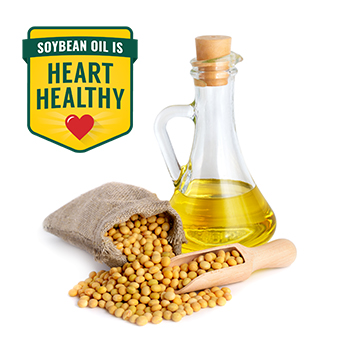The U.S. Food and Drug Administration (FDA) has approved a total of 34 qualified health claims (QHCs).1 One of the most recent pertains to reduced risk of coronary heart disease (CHD) by edible oils high in oleic acid such as high oleic soybean oil:
“Supportive but not conclusive scientific evidence suggests that daily consumption of about 1½ tablespoons (20g) of oils containing high levels of oleic acid, when replaced for fats and oils higher in saturated fat, may reduce the risk of coronary heart disease. To achieve this possible benefit, oleic acid-containing oils should not increase the total number of calories you eat in a day. One serving of [x] oil provides [x] grams of oleic acid (which is [x] grams of monounsaturated fatty acid).”
However, the veracity of QHCs has been called into question by some organizations because the distinction between QHCs and their authorized counterparts may not be clear.2 An understanding of the regulatory basis for such claims may be helpful for health professionals to guide consumers.
Authorized Health Claims
Authorized health claims (AHCs) must meet a rigorous standard called “significant scientific agreement (SSA).”3 This standard is so rigorous that only 5 AHCs have been authorized since the 7 original claims enacted with the Nutrition Labeling and Education Act of 1990. An onerous process is required to authorize new AHCs. FDA must publish a proposed claim (usually in response to a public petition) in the Federal Register that solicits comments and address them in writing before publishing a final rule which is codified in the Code of Federal Regulations (CFR). This process takes a minimum of 540 days (21 CFR §101.70). AHCs must use the words “may” or “might” but are not required to include other qualifying language.
Qualified Health Claims
QHCs must be substantiated by the “preponderance of the scientific evidence,” but do not meet the SSA standard. The process used to authorize such claims is less onerous than for AHCs, but is still scientifically rigorous. In fact, the same type of petition must be submitted to FDA to apply for both types of claims (21 CFR §101.14). This petition includes a detailed review of the totality of the scientific evidence as well as other technical and safety considerations. FDA evaluates the evidence and solicits public comments, but renders its decision by posting an Enforcement Discretion letter on its website rather than codifying a formal regulation. FDA can also flatly deny QHC petitions. This process takes a minimum of 270 days.
An important part of the review process is determination of the appropriate qualifying language. Such language ranges from the least restrictive, “Supportive but not conclusive scientific evidence suggests” to the most restrictive, “Little scientific evidence supports this claim.” Claims with the least restrictive language are substantiated by a considerable amount of scientific evidence. For example, the oleic acid claim noted above is based on 7 well controlled dietary intervention studies, and a similar QHC for conventional soybean oil and reduced risk of CHD is based on 6 such studies. On the other hand, the QHC for chromium picolinate and reduced risk of type 2 diabetes is based only on 1 small study and is required to state, “FDA concludes, however, that the existence of such a relationship between chromium picolinate and either insulin resistance or type 2 diabetes is highly uncertain.”
High Oleic Oils, Vegetable Oils
Health claims, including the high oleic oil claim noted above, can be useful sources of information for consumers; especially when health professionals provide additional perspective. High oleic vegetable oils were developed largely for their functional benefits as replacements for trans-containing partially hydrogenated oils.4 For example, high oleic soybean oil has been shown to have greater oxidative stability and fry life compared to its conventional counterpart due to its lower polyunsaturated fatty acid content.5
Controlled intervention studies have shown that high oleic vegetable oils have cardioprotective properties. A systematic review of such studies6 reported that dietary substitution of oils with at least 70% oleic acid for oils higher in saturated fatty acids lowered blood total cholesterol (TC) and low-density lipoprotein cholesterol (LDL-C) (p<0.05) with no changes in triglycerides (TGs) or high-density lipoprotein cholesterol (HDL-C) concentrations. Analogous substitution for trans-containing oils showed reductions (p<0.05) in TC, LDL-C, and TGs concentrations, and increases in HDL-C.
These data give considerable credence to the QHC for high oleic oils. Edible oils that contain at least 70% of oleic acid per serving are eligible to bear the claim. High-oleic oils that qualify include soybean (75.7%),7 canola (71.5%),8 safflower (74.7%), and sunflower (83.7%). Conventional olive oil also qualifies for the claim (71.3%).
In conclusion, QHCs can be useful tools to help health professionals educate consumers about choosing healthy diets.
REFERENCES
- Qualifed Health Claims: Letters of Enforcement Discretion. 2020. at https://www.fda.gov/food/food-labeling-nutrition/qualified-health-claims-letters-enforcement-discretion.
- Hooker NH, Teratanavat R. Dissecting qualified health claims: evidence from experimental studies. Crit Rev Food Sci Nutr 2008;48:160-76.
- Kinney AJ, Knowlton S. Designer oils: the high oleic soybean. In: Harander S, Roller S, eds. Genetic engineering for food industry: a strategy for food quality improvement. London: Blackie Academic; 1997:193-213.
- Mermelstein NH. Improving soybean oil. Food Tech 2010;68:1-20.
- Huth PJ, Fulgoni VL, 3rd, Larson BT. A Systematic Review of High-Oleic Vegetable Oil Substitutions for Other Fats and Oils on Cardiovascular Disease Risk Factors: Implications for Novel High-Oleic Soybean Oils. Advances in nutrition 2015;6:674-93.
- Napolitano GE, Ye Y, Cruz-Hernandez C. Chemical Characterization of a High-Oleic Soybean Oil. Journal of the American Oil Chemists' Society 2018;95:583-9.
- USDA National Nutrient Database for Standard Reference, Release 28 (Slightly revised). Version current: May 2016. 2016. (Accessed November 30, 2020, at http://www.ars.usda.gov/nea/bhnrc/mafcl.)

Connect with us through our social channels